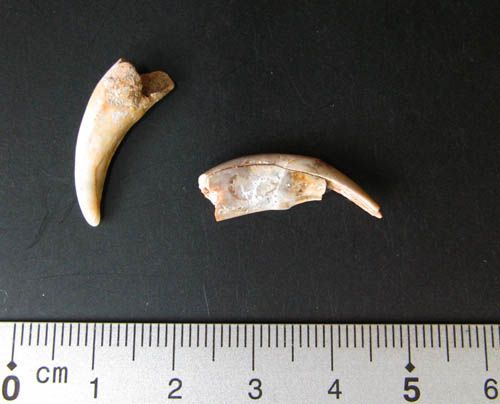The two fox (vulpes vulpes) teeth were excavated from Paviland Cave near Port Eynon. The teeth date from the Palaeolithic era and have holes bored in them, the purpose most likely to form a necklace. The fox teeth were found in Paviland cave on the Gower.

The earliest evidence of human activity in Wales are Neanderthal teeth from Pontnewydd Cave in North Wales and are approximately 250,000 years old. From that point until now human activity would have come and gone in waves as the climate varied and for long periods Wales would be under ice sheets and uninhabitable.
In 1823 the Oxford archaeologist, the Rev. William Buckland found a skeleton and various other mammal remains in the cave. His thesis was that various bones of extinct animals and bones of animals now confined to Africa was evidence of the Bible story Noah’s flood. The skeleton became known as the Red Lady of Paviland. Buckland identified the skeleton as female due to it being buried with a necklace and from the Roman period as according to theological thinking at the time, the earth was no older than around 6500 years old. Buckland was wrong on both counts. The skeleton was male and around 32,000 years old.
This remains the oldest ritual burial discovered in Europe. The body was placed with objects, including a mammoth’s head and ochre, a mineral which over time stained the bones red, hence the name Red Lady. Paviland Cave at this time would not have been overlooking the sea. It would have overlooked grass tundra and the sea would be about a fifty mile walk away. These early humans were hunter gatherers, who had moved out of Africa and entered Europe around 45,000 years ago.
Later an Ice Age would force them to retreat, along with various species of mammal. Paviland Cave also contained various mammal remains including those of hyena and elephant along with various extinct species including woolly rhinoceros and mammoth for example SM 1836.6.21. A mammoth tooth excavated in 1823 and carbon dated to around 41,000 years old.
We do not know what these early arrivals in Wales believed in but a ritual burial indicates some form of culture and belief.
The final retreat of ice began about 10,000 BCE and what we recognise as the coastline of Wales emerged around 6,000 BCE. By around 3000 BCE the climate was around 2.5 centigrade higher than today.
In 1903 Cheddar Man was discovered, the oldest complete skeleton found on the British Isles. The remains were radio carbon dated to around 10,000 BCE, a full 20,000 years later than `the Red Lady’.
It was assumed that after entering Europe around 45,000 years ago, humans would have quickly adapted paler skin to allow for better absorption of vitamin D. That does not appear to be the case, DNA extracted from the skeleton of Cheddar Man shows that the genetic markers for skin pigmentation are associated with sub Saharan Africa.
Like Cheddar Man, the Red Lady of Paviland was not red and probably not Caucasian either.
Black history on the British Isles started long before the Empire Windrush arrived in 1948.

